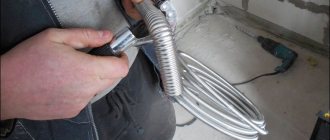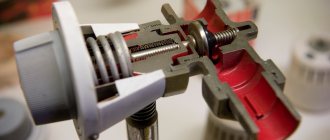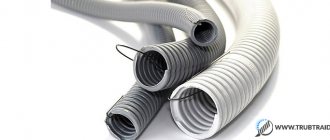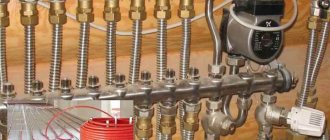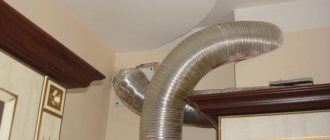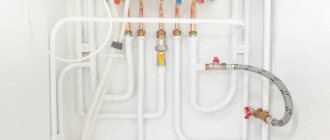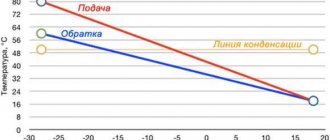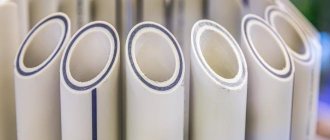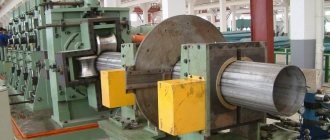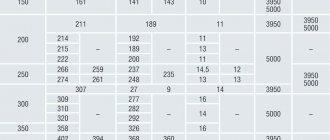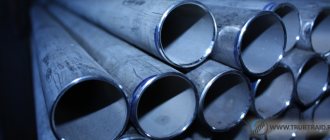Technological progress does not stand still. He did not bypass the construction industry in terms of equipment for heating systems. Twenty years ago, specialists mastered the technology of installing plastic and bimetallic pipes. And now corrugated stainless steel analogues for heating systems appear. True, this is considered a novelty only for the post-Soviet market, but they were invented at the end of the last century. Let's study in more detail the development of Japanese engineers.
Technical Specifications of Corrugated Stainless Steel Pipe
Standard stainless steel products for heating systems are produced with diameters of 15, 20, 25, 32 mm. All other sizes are possible, but only by individual agreement with the manufacturer. Let's take a closer look at the characteristics of corrugated pipes with parameters of 15 and 20 mm:
- Stainless steel product with an indicator of 15 mm:
- outer diameter – 18.1 mm;
- internal effective diameter – 14.1 mm;
- wall thickness – 2.5 mm;
- minimum permitted bending radius – from 35 mm;
- operating coolant temperature at a pressure of 10 bar – from 0 to 100 °C;
- pipe length in a coil is 50 meters;
- coil weight – 7.8 kg.
- Stainless steel product with an indicator of 20 mm:
- outer surface diameter – 25.6 mm;
- internal diameter – 21.0 mm;
- wall thickness – 2.5 mm;
- minimum bending radius – from 50 mm;
- operating temperature of the carrier at a pressure of 10 bar – from 0 to 100 degrees Celsius;
- the length of the corrugation in the bay is 30 meters;
- coil weight – 6.0 kg.
The products can withstand short-term temperature surges up to 150 °C and pressure up to 210 atmospheres, although such indicators can cause destruction.
The thermal conductivity of such pipes is higher than even copper ones, and due to the corrugation, the percentage of heat transfer increases by more than 30 units.
Manufacturers and what to look for when purchasing
There are currently the most Korean companies in our market:
- KOFULSO (“Kofulso”) - according to experts, the best quality, since it was the first to appear on the market and has quite a lot of production experience. It has twice the thickness of the seal rings in the fittings, and the weight of the fittings and coils of pipes of the same name is greater. So the increased cost (compared to Hydrosta and Lavita) is justified.
- Lavita (“Lavita”) - performs quite well, but there may be problems in the fittings - sometimes when tightening, the metal ring cuts through the wall (may be due to an installation error - tightening the clamping ring), which causes leaks (per 100 fittings 1-2) - costs less than Cofulso.
- Hydrosta (“Hydrosta” or “Hidrosta”) is in the same price category as Lavita, but there are complaints about leaking fittings: for every 100 installed, 5-7 pieces leak.
- Neptune (“Neptune”) – characteristics and reviews could not be found;
- Meibes (Meibas) - there are no complaints about the quality, but there are some for the price - very expensive with approximately equal parameters to those given above in the list.
The reliability data was taken from the installer’s post on the forum, this is the result of several years of use: first we worked with Cofulso, then switched to the cheaper Lavita and Hirostat, after replacing fittings and, accordingly, customer complaints, we weighed, looked, and returned to KOFULSO.
What product shortcomings should we not forget?
- The downside is the high price - this is a controversial issue, since the material itself is not cheap, plus a unique manufacturing technology. The low price of such a thing should alert you, most likely it is a fake. When making a purchase, check the integrity of the packaging - there are markings on it, there are no inscriptions on the pipe.
- Another feature manifests itself during operation and saddens housewives: dust accumulates in the depressions of the pipe, which is difficult to wash out.
- The products are afraid of external mechanical damage; special screens will provide protection.
- The disadvantages of the connections include the fact that the fittings require regular maintenance.
- If part of the heating system is located in an open room, additional insulation is required to avoid heat loss.
- Twisting is not allowed.
- There is a possibility of corrosion caused by electrochemical processes (grounding saves).
Purpose and application
Corrugated pipe is used as a chimney for a heating boiler.
Corrugated pipes are widely used in construction and repair. They are often used in the following areas:
- rainwater drainage system equipment;
- organization of disposal of municipal wastewater;
- drainage assembly;
- installation of a heating system;
- ensuring the flow of water into the apartment under pressure;
- gas supply indoors;
- connection of air conditioners.
The corrugated pipe for heating determines its purpose, since the surface has high heat transfer; the thick rings on the pipe can act as a radiator.
Corrugated pipes have found their application in the industrial and domestic spheres for laying electrical and television cables. Pipes reliably protect from mechanical damage and the influence of weather conditions.
In the construction of private houses, corrugated pipes are widely used for water supply and heating systems.
Advantages of using stainless steel corrugation in heating systems
Corrugated stainless steel pipes have features that set them apart from other types of heating pipes:
- They bend in all directions (a large bending radius even helps to build a radiator or heated towel rail from corrugated material). This property of the product allows it to be used in rooms of different configurations, eliminating the need to purchase rotating corners as in products made of plastic and metal.
- They are not afraid of negative temperatures (if your heating system is frozen, the integrity of the pipe will not be compromised, and you can thaw it using any available methods).
- They have high strength (withstand pressure over 200 atmospheres).
- Do not react to atmospheric influences (do not rust).
- They have good heat dissipation.
- Suitable for laying heated floors and laying in the wall.
- Withstands temperatures up to 150 degrees.
- Not exposed to fungus.
- They have a low roughness coefficient, which maintains high throughput without the use of additional equipment.
- They are not afraid of rodents.
- Easy to install, require a minimum of connecting elements, cut with a pipe cutter.
- Convenient to transport.
- Can be dismantled without difficulty.
Subject to operating rules, manufacturers set a minimum service life of 20 years.
Permissible period of operation of water pipes made of polyvinyl chloride
] collectors made of polyvinyl chloride [/anchor] for cold water supply pipelines estimate the durability of their products at 55-60 years. In order for such materials to last for the specified period of time, they will need to be operated at a temperature of 65 to 75⁰C and with a maximum pressure in the system of 4-6 a] Supplying water with a temperature of about 20⁰C[/anchor] at the same pressure also provides a full warranty service life of plastic water pipes.
Plastic collectors are produced by manufacturers in various modifications, which helps to expand the scope of their application. Currently, on the market of materials for communication systems you can find products with an internal diameter in the range of 90-630 mm. Among them there are materials that can be operated at a maximum pressure in the system of up to 16 bar. At the same time, such models are distinguished by their low price and practicality of use.
Other advantages of PVC water supply manifolds include:
- Excellent throughput due to the smooth surface of the raw material.
- Ease of connecting sections and installing structures.
- Resistance to chemically aggressive substances, corrosion, ultraviolet radiation.
- Affordable price.
When using such products, the formation of deposits and the proliferation of microorganisms in the system is eliminated. Moreover, such products do not support combustion, which makes them safe for human use in everyday life.
The service life of a PVC water supply depends on the pressure under which the liquid will be supplied to the network and what its temperature will be. The conditions under which the pipes will be laid and subsequently used also affect the service life of the products.
When laying underground water supply systems from polyvinyl chloride pipes, you need to pay attention to their low resistance to mechanical factors. Therefore, in order not to intentionally shorten the service life of materials, it will be necessary to provide additional protection for the structure in advance in the form of foam boxes and other similar installations.
You also need to remember that at ambient temperatures below -15⁰С, it is strongly not recommended to use PVC pipes without additional insulation. The service life of products in such conditions will sharply decrease, and you will be forced to replace the system. Such nuances must be taken into account before laying an external water supply line, at the planning stage of a future engineering project.
If we take the service life of polypropylene pipes as an example, the table clearly demonstrates the relationship between the conditions of use of the products and their durability:
Price
Prices depend on the country where they are produced, the company, the diameter, whether the products are annealed or not, as well as the presence of a polypropylene coating. When using a small piece of pipe for connecting to a heating boiler or connecting radiators, you should opt for the budget option, and if you are a wholesale buyer and require at least a whole coil, then do not be lazy to look at the price lists of different companies. Sometimes you can get discounts.
Let's compare the prices of two well-known brands in this industry (per meter):
- Flexor Group of Companies (official distributor of Hydrosta). The minimum prices in rubles for annealed, unannealed and polypropylene-coated pipes are listed, respectively.
- HF20 – from 185.80, from 153.14 (with discount), from 240.96;
- HF25 – from 243.14, from 270.72, from 308.46;
- HF32 – from 464.50, from 524.01.
- “Lavita” (only annealed corrugation is presented), cost in rubles:
- HF20 – from 222;
- HF25 – from 277.50;
- HF30 – from 516.15.
The prices given are not a public offer and may vary.
The pipe and its components must be from the same company.
Heating systems
Due to their poor resistance to temperature changes and their high performance, polyvinyl chloride pipes are not usually used in heating systems. The operating temperature limit for such collectors is 70-75⁰С. With such indicators, the material becomes softer and its elasticity increases. As a result, deformation of the products may occur, which can lead to breakdown and the need to replace the heating line.
Even if you decide to use PVC pipes in the heating system, you should avoid large fluctuations in temperature conditions. When implementing a heating project using such collectors, it will also be necessary to place their fastenings much closer to each other in order to avoid deflections.
Most often, polypropylene materials are used to supply hot water in heating networks. Their service life in the heat supply sector significantly exceeds that of polyvinyl chloride. They can supply substances with temperatures up to +90⁰С, and even if there is a sharp jump to +110⁰С, the collectors and the main line will not be affected. An ideal option for arranging thermal systems are polypropylene materials marked PN25, indicating the reinforced structure of the workpieces.
In conclusion, it is worth recalling that the shelf life of plastic pipelines directly depends on what will be transported through them. When choosing a specific sample, it is necessary to clarify for what conditions it is intended and in what temperature conditions are considered optimal for it. I would also like to note that plastic pipes whose service life has expired must be replaced with new products. Timely replacement of consumables will ensure the reliability and quality of household communications.
Watch the video:
How to make a corrugated pipe from stainless steel
High quality steel strip is sent to the forming line. There, on bending machines, it is given the outline of a cylinder. When rolling, special clamps are used, and the cylindrical blank becomes a corrugated pipe.
The product blank is placed in a chamber, filled with a special gas mixture, in the environment of which welding takes place. The entire process is automated, which allows you to achieve a high-quality weld and eliminate the human factor.
To achieve plasticity, the products are additionally annealed: heated to 1000 degrees, then cooled to 200 °C.
The pipe is cut into pieces ranging from 20 to 50 meters in length, which are rolled into a coil, packaged and labeled.
Results
Judging by the reviews, the picture is even too rosy: no one is complaining. This is even a little alarming. But maybe it’s just that not much time has passed: they began to actively install stainless corrugated pipes for heating just a few years ago and the “sides” have not yet come out. Although, if there were serious problems, they would have already manifested themselves, and negative messages would definitely appear: a person is more inclined to describe why he does not like the product than to write about problem-free operation.
Whether or not to install stainless steel corrugation for heating is up to everyone to decide for themselves, but everything looks quite attractive: prices, characteristics and ease of installation. Even the reviews are encouraging.
Manufacturer's choice
Corrugated stainless steel pipes were invented at the end of the twentieth century in Japan, but manufacturers in the post-Soviet space mastered the technology recently – a few years ago. Products are produced both at the parent enterprises and in companies that are their official divisions. The quality of the products does not suffer, since production is carried out on imported equipment in compliance with all standards.
Manufacturers
KOFULSO is a company from South Korea that produces corrugated stainless steel pipes with a special polyethylene coating in different colors.
NEPTUN is a Russian company that produces high-quality products at affordable prices.
INOFLEX , a German branch of MEIBES, offers finished products in coils up to 80 meters. They are also used in solar-powered installations.
LAVITA is another company from South Korea. Corrugated stainless steel pipes are produced in annealed and unannealed form.
What to look for when purchasing
When purchasing a corrugated stainless steel pipe, you need to look at the packaging of the coil - its integrity should not be compromised. The products are expensive, and unscrupulous sellers are tempted to offer counterfeits. This may affect operational safety.
The integrity of the packaging is also important because there are no markings on the corrugated pipe itself, so keeping the packaging will help you not make a mistake in choosing the desired diameter of the corrugated pipe.
You should carefully examine the product itself and hold it in your hands. High-quality corrugation bends easily, and what is important is that it does not spring back, trying to return to its previous state. A good pipe has an even butt seam and uniform distances between the corrugation rings. There should be no dents, chips or scratches on it. If you find defects, look for the product in another store.
When purchasing a corrugated pipe for connecting to plumbing fixtures or a heating boiler, you can estimate the size by eye. To use the product in heating systems, accurate calculations are required. Having decided on the size, add another meter - one and a half for “seam allowances”.
To avoid troubles when operating the heating system, you need to approach the selection of components for the corrugated pipe no less responsibly. Experts recommend using “original” fittings manufactured by the same company that produces the corrugated pipe. You should also check all parts for defects.
Installation features
Corrugated pipes for heating and other communication systems are connected using brass fittings (without a fitting). In order to make installation quickly and without complications, purchase components from the same manufacturer as the corrugated hose.
Fitting complete set
When laying pipes, you do not need to stretch it in length, as this will increase the stress. It should maintain its natural shape, without tension or sagging.
Assembly steps:
- Cut the pipe with an even straight cut. It is convenient to do it between the links of a corrugated sleeve. To do this, use a metal file, grinder and other tools. Experts use a roller pipe cutter. The edges should not have jagged edges; they should be cleaned with abrasive materials.
- The pipe is crimped using the internal gasket part of the connection (compression fitting). The corrugated hose is inserted into the fitting, then tightened with the union nut from the kit.
- The shape required according to the project is given, then fixed using special fasteners.
- The last stage is checking the system. It is made under more pressure than a worker. In places of leakage, carefully tighten the nuts.
Methods for installing a fitting
This is what the general installation diagram looks like. Its specifics depend on the purpose of the pipeline.
